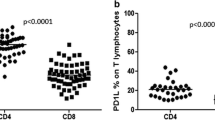Abstract
he pathogenic mechanism of tonsillar hypertrophy is unknown and lacks a proper infectious or immunological explanation. Epidemiological studies point to polluted environments as the main cause of tonsillar hypertrophy in the adaptation of the juvenile organism. Tonsils and adenoids of 67 children aged 2–16 years (mean 5.9 years) were divided into three groups: recurrent tonsillitis (n=21), recurrent tonsillitis with tonsillar hypertrophy (n=21) and tonsillar hypertrophy without history of tonsillitis (n=25). The following biological markers were studied: anti-streptolysin O antibody and anti-deoxy ribonuclease B antibody serology, microbiology and cell count of granulocytes in tonsils and adenoids as well as lymphocyte subsets and “ex vivo” endonuclease activity in tonsils. Anti-streptolysin O antibody and anti-deoxyribonuclease B antibody titres were significantly raised in recurrent tonsillitis. Positive bacterial cultures for Streptococus pyogenes were rare in cases of tonsillar hypertrophy. T-lymphocytes counts were lower and the proportion of basophils was higher in hypertrophic tonsils than in recurrent tonsillitis. Two parameters of apoptosis were studied; the activation of endonuclease, inducing breakdown of DNA resulting in cell death, and the sensitivity to thapsigargin, known to trigger the cleavage of DNA by apoptotic endonuclease. In children with tonsillar hypertrophy both parameters were decreased contrasting with those with recurrent tonsillitis where apoptosis is increased. It may be speculated that the increase of basophils in children with tonsillar hypertrophy results in increased release of interleukin-4, which could prevent lymphoid apoptosis and lead to cell proliferation in tonsillar tissue.
Conclusion Whereas recurrent tonsillitis is characterised by apoptotic death of lymphoid tissue, tonsillar hypertrophy is caused by environmental pollution agents that trigger the chronic inflammatory process without apoptotic cell death.
Similar content being viewed by others
Author information
Authors and Affiliations
Additional information
Received: 8 July 1997 / Accepted in revised form: 2 April 1998
Rights and permissions
About this article
Cite this article
López-González, M., Díaz, P., Delgado, F. et al. Lack of lymphoid cell apoptosis in the pathogenesis of tonsillar hypertrophy as compared to recurrent tonsillitis. Eur J Pediatr 158, 469–473 (1999). https://doi.org/10.1007/s004310051122
Issue Date:
DOI: https://doi.org/10.1007/s004310051122




